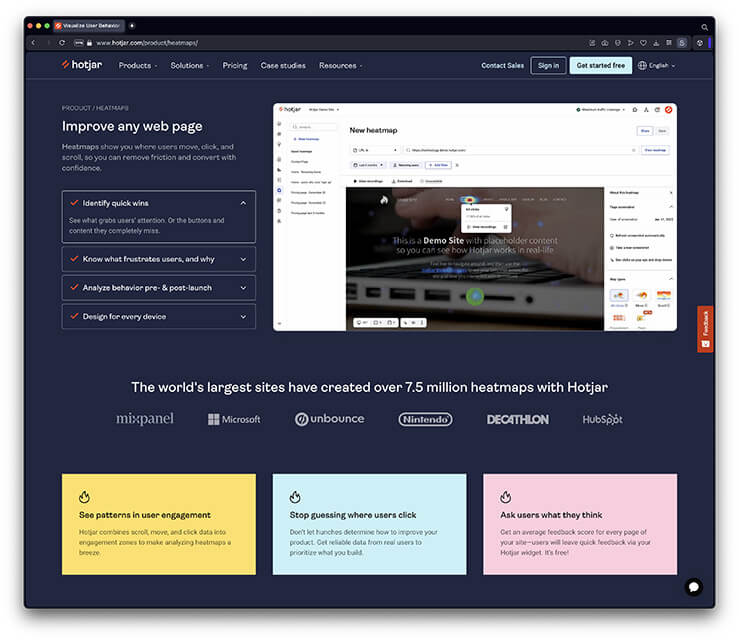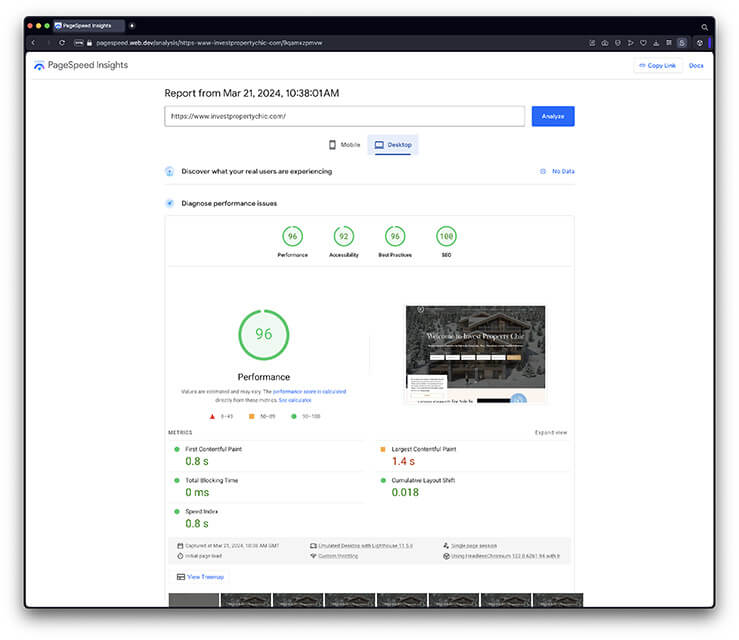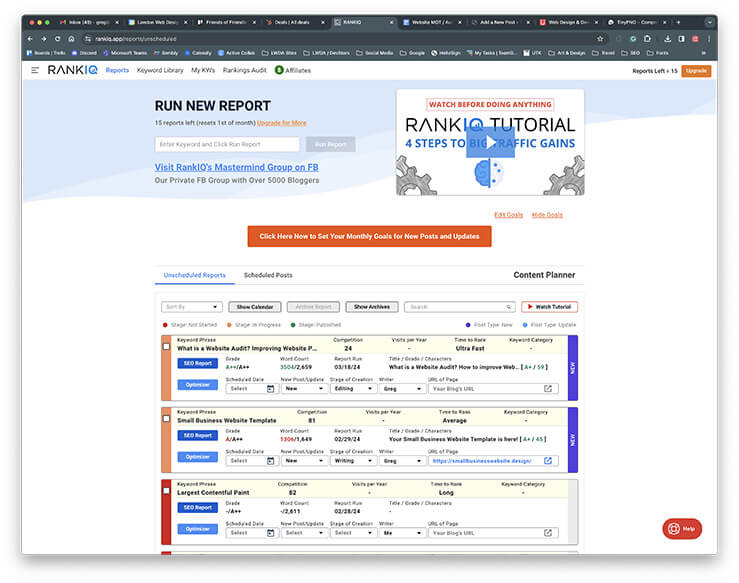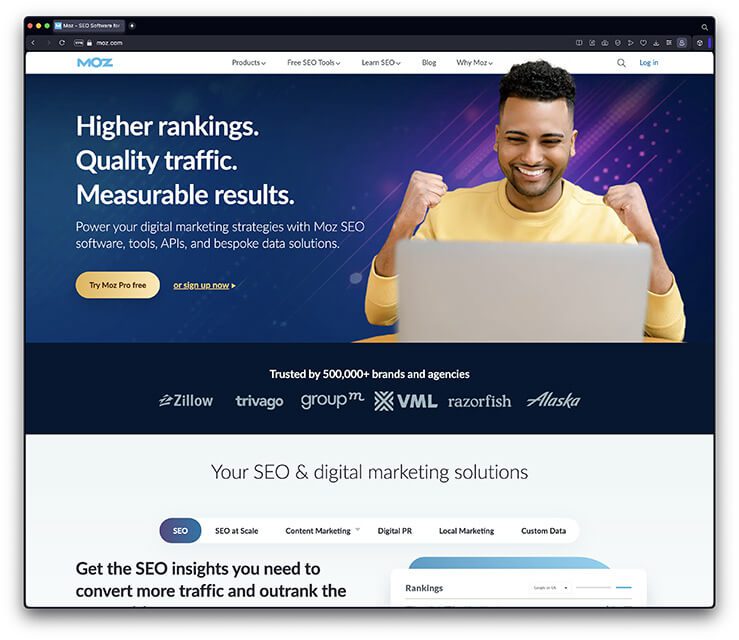
Article
What is a Website Audit? How to improve Website Performance
PUBLISHED:March 21, 2024
In the digital landscape, where websites serve as the storefronts of businesses, ensuring their optimal performance is paramount. However, even the most meticulously designed websites can encounter issues that hinder their effectiveness. This is where a website audit comes into play.
A website audit is a comprehensive examination of a website’s performance, functionality, and SEO health. It involves analysing all aspects of the site to identify potential issues or areas where improvements can be made.
Importance of website audits for businesses
For businesses, a website audit is invaluable as it provides insights into how well the site is performing and where there is room for improvement. By addressing issues uncovered during the audit process, businesses can ensure their website remains competitive and user-friendly.
Types of website audit
There are several different types of website audits, each focusing on different aspects of the site:
Technical Audit
A technical audit evaluates the backend infrastructure of a website, including server configurations, website speed, and security protocols. It identifies technical errors that may impact the site’s performance or user experience.
SEO Audit
An SEO audit assesses the website’s visibility and ranking on search engine results pages (SERPs). It examines factors such as keyword optimisation, internal links, and site structure to identify opportunities for improving search engine visibility.
Beyond the confines of your website, off-page factors exert a significant influence on your online visibility. Backlink profiles, social signals, and online reputation are scrutinised during an SEO audit to gauge the overall authority and credibility of your digital presence. This is often referred to as off-site SEO.
Content Audit
A content audit evaluates the quality and relevance of the content on a website. It involves analysing existing content, identifying gaps or inconsistencies, and recommending strategies for optimising content to better engage the target audience and improve SEO performance. This is often referred to as on-site SEO.
Benefits of Conducting a Website Audit
The benefits of conducting regular website audits are numerous, with the ultimate aim being a vastly improved website that is easy to use, runs as smoothly as possible and outperforms the competition in Google search results.
A comprehensive website audit is the best way to identify potential problems across all areas of the website. The resulting website audit report would not only outline these issues but also suggest ways to fix the problems. The issues identified in the report can then be fixed by the website owners or a third party, such as a web development company or digital marketing agency.
The benefits of conducting a website audit include the following:
1. Identifying technical issues
A website audit helps identify technical aspects that may be affecting the site’s overall performance, such as broken links, slow page loading times, or security vulnerabilities. In fact, you may already be aware of these issues, which is what’s led you to consider having an audit performed on your website. However, the problems that you’re experiencing may not end there, which is why it’s important to remember that a professional website auditing tool will help identify problems that can not necessarily be seen or experienced within a web browser.
2. Improving user experience
By addressing issues uncovered during the audit, businesses can enhance the overall user experience of their website, making it more intuitive and user-friendly.
Free tools such as Google Search Console can help identify web pages that are underperforming in terms of visitor numbers, showing a high bounce rate or low conversion rate. The reason for these problems is likely design-related and may require a review of the website’s structure and user interface.
Combining insights gained from Google Search Console with those from heat-mapping tools such as Hotjar will help highlight the parts of your web pages that are failing, such as buttons (where they are placed, their colour and size, etc), navigational devices and other interactive elements.
Reviewing the UI & UX of your website is often referred to as a design audit. The services of a website designer will be needed to make any changes highlighted in the report, but the result should be increased user engagement, which should lean to a higher conversion rate (more purchases, sign-ups, etc).
3. Enhancing SEO performance
An SEO audit can uncover opportunities for improving the website’s search engine visibility, such as optimising meta tags, improving site structure, or targeting new keywords. The act of making these improvements is known as Search Engine Optimisation and should be an ongoing task, monitored regularly in line with your overall marketing strategy. If your company only exists online, with no offline marketing, then this task will commonly be referred to as your SEO strategy.
How to Perform a Website Audit
A highly detailed and complete website audit would usually be carried out by a dedicated digital agency, but depending on the type of audit you wish to run and the budget available, you may wish to perform the audit yourself. Some tasks can be performed manually and some will require the use of online tools.
Manual inspection
Manual inspection of a website to identify areas of concern can be a lengthy process depending on the size of the site, but it can save a little money if you are happy to manually move from page to page, testing all links and interactions.
Checking for broken links, testing website functionality such as navigational devices and forms, and reviewing content for accuracy and relevance should help you pinpoint on-site problems that need fixing. It’s then just a case of logging into your CMS to fix broken links, navigation and forms, and update the website’s content to improve performance.
While logged into the CMS, you should also take the opportunity to review metadata, such as page titles, meta descriptions and image alt-tags, all of which should be optimised in line with your SEO strategy.
If you have problems making the required changes, you will need to seek the assistance of a web developer or digital marketing agency.
Using online tools
There are various online tools available that can automate the website auditing process. Some are free, but most are paid-for, requiring monthly subscriptions for the life of the account.
Google’s PageSpeed Insights is a free tool that shows how quickly your website loads on desktop and mobile devices. The score is marked out of one hundred, with a low score signifying problems with page load speed. Scores are also given for accessibility, best practices and SEO. The aim is to get as many of these to show green (90+).
Paid tools include the likes of SEMrush and Moz’s Site Crawl. These tools provide detailed reports on various aspects of the site’s performance and identify areas for improvement. Moz offers a few free tools that will help you get an idea of how your website is performing, but you’ll need to subscribe if you want the full in-depth report.
A paid-for website audit tool such as SEMrush is particularly good at providing technical recommendations that a manual inspection is unlikely to identify, so if you plan on auditing your website yourself, we suggest subscribing to one of the paid tools, even if just for a few months whilst you review your website and make changes.
Key Elements to Evaluate During a Website Audit
When performing a website audit, be it manual or using a powerful tool such as SEMrush, there are a few key elements that you should evaluate and rectify as soon as possible if problems are found.
Site speed and performance
Website speed and performance are critical factors that can impact user experience and search engine rankings. A website audit should assess the site’s loading times, server response times, and overall performance across different devices and browsers.
If you find that your web pages are slow to load, you can reduce loading times by actioning the following steps:
- Optimise images – Make sure that all of the images on your website are fully optimised in terms of physical size (width and height in pixels), and file size, and make sure that you choose the correct image format for the intended use.
- Optimise Server Performance – Not all web servers are created equal, and depending on the platform you use for your website, you may need to change your hosting platform. For example, WordPress websites are often better hosted with a service such as Kinsta or WP Engine.
- Use a CDN (Content Delivery Network) – Whether you change your hosting or not, it’s a good idea to use a CDN to help distribute your web page as quickly as possible to your users around the world.
After following the above steps, if your pages still take a long time to load, it may be that the website code itself is bloated and badly written. If this is the case, you may need to invest in a new website, but this should be a last resort.
Mobile responsiveness
With an increasing number of users accessing websites on mobile devices, it’s essential for websites to be mobile-responsive. A website audit should evaluate how well the site performs on mobile devices and identify any issues that may affect the mobile user experience.
Google Search Console will alert you if elements of your website are not optimised for mobile devices, such as font sizes not being big enough or buttons being too close to each other.
Speed once again plays an important role when accessing websites from mobile devices, especially if the user is experiencing a poor connection through their provider. Actioning the steps outlined above will help overcome poor performance on mobile devices and boost user satisfaction in the process.
Content quality and relevance
High-quality, relevant content is crucial for engaging users and attracting search engine traffic. An audit should assess the quality, relevance, and effectiveness of a site’s content, identifying opportunities for improvement and optimisation.
Using an SEO audit tool such as the Keyword Gap tool in SEMrush helps you compare your keyword profile with your competitors. Any keywords that your competitors rank for but you do not are an opportunity to create new content that targets potential customers and increases organic traffic.
Finally, as part of your SEO website audit, we suggest using RankIQ to optimise old content. RankIQ is a powerful tool for identifying keywords related to any subject that you might be writing about. Just take care not to fall foul of keyword stuffing.
Updating old blog posts, service pages and case studies with more detailed information is a great way to boost relevance in the eyes of your target customer and position your company as an authority within your business sector.
Common Issues Uncovered During a Website Audit
There are several common issues usually uncovered during technical SEO audits, each of which needs to be rectified as a matter of urgency. Think of these as the low-hanging fruit. Problems that can be fixed relatively quickly and immediately contribute to a healthier website in the eyes of search engines.
Broken links
Broken links can negatively impact user experience and SEO performance. A website audit should identify any broken links and recommend strategies for fixing or redirecting them.
Broken links are often classified as follows:
- Missing images – Broken image links are quite common. They can happen as a result of someone deleting an image file from the website, a change in URL structure, or filename, or a website migration that might not have transferred all image files to a new server.
- Broken links (internal) – Internal linking between web pages is a vital part of any SEO strategy. If a page is deleted or the URL changes, all other pages pointing to that page will suffer from a broken link signal.
- Broken links (external) – It may sound strange, but adding links to external websites does have a positive impact on your SEO. If you are writing an article about a particular subject, you should consider including links to third-party information to help add weight to your findings. But sometimes these links break and so you’ll need to fix them.
Fixing broken links is an essential step towards improving the overall health of your website and boosting SEO as a result.
Duplicate content
Duplicate content can confuse search engines and dilute the authority of a website. A website audit should identify any instances of duplicate content and recommend strategies for consolidating or removing duplicate pages.
We often see clients creating posts which are almost identical to ones that they have posted before, with just a few details changed to bring the content up to date. In this situation, it’s often best to update the original article and re-share it via social media or the company newsletter. That way the content is always fresh and will not compete with any other page on the website, avoiding the risk of being flagged as duplicate content by Google.
The same applies to content that has been plagiarised from other websites. Never, under any circumstances, copy & paste content from another website and try to pass it off as your own. Search engines have ways of detecting this behaviour and they will penalise your website if you plagiarise content as a part of your SEO strategy.
Indexing problems
Indexing problems can prevent search engines from properly crawling and indexing a website’s pages. A website audit should identify any indexing issues and recommend strategies for improving the site’s crawlability and indexability.
Fixing indexing problems is a crucial step towards improving site health, so don’t delay in executing this task. It’s likely best tackled by a web developer, so ask your dev team to fix any page indexing issues that get flagged during the audit ASAP.
Interpreting Website Audit Results
Depending on the type of website audit and the size of the site, you’ll need to interpret the results and put together a plan of action for fixing any of the issues that have been reported.
Prioritising issues
Once the audit is complete, the first step is to prioritise the issues uncovered based on their severity and impact on the site’s performance and user experience.
As mentioned above, issues such as indexing problems should be fixed as a matter of urgency, along with broken links and speed problems. Other tasks such as creating new content are less important and would take longer to implement, so they can be knocked down the priority list.
Very often, the tools used to run website audits will help you prioritise issues by colour-coding them (green, orange, red) or giving them some sort of numerical score which helps you denote the severity of the problem. So, if you are unsure of which tasks to prioritise, let these tools act as your guide, working through each task on their list, one by one, until all issues have been fixed.
Creating an action plan
After prioritising the issues, businesses should create an action plan for addressing them. This may involve fixing technical performance issues, optimising content, or implementing SEO strategies to improve search engine visibility.
Different members of your team may be given particular problems to fix. Your web development team will likely take on many of the technical issues, whilst others tackle content-related issues. By allocating responsibility for each task to a different person or department, all of the problems flagged in the audit can be fixed in a timely manner.
Tasks such as creating new content that targets additional keywords will require more time to complete and will likely form a crucial part of your ongoing SEO strategy.
Tools for Website Auditing
Many free and paid-for auditing tools will let you undertake an in-depth analysis of a website. These are just a handful of our favourites:
Google Analytics
Google Analytics provides valuable insights into website traffic, user behaviour, and conversion rates. It can help businesses identify areas for improvement and track the effectiveness of their website optimisation efforts.
Google Analytics – often referred to as GA or GA4 – should ideally be used in conjunction with PageSpeed Insights and Search Console to reveal the most insight. All are free to use, so if you don’t already have GA4 code installed on your website, ask your dev team to action this ASAP so that you can start to track user numbers and other useful stats.
SEMrush
SEMrush is a comprehensive SEO tool that provides insights into technical issues, keyword rankings, backlink profiles, and competitor analysis. It can help businesses identify opportunities for improving their search engine visibility and optimising their website for better performance.
Screaming Frog
Screaming Frog is a powerful website crawling tool that can identify technical issues, such as broken links, duplicate content, and missing meta tags. It provides detailed reports on various aspects of a website’s performance and helps businesses identify areas for improvement.
Moz
Moz is a multi-faceted website auditing tool that provides a comprehensive review of a website from both a technical and SEO perspective. It provides insights into a website’s performance, identifies technical issues, and suggests optimisations to improve search engine visibility. Moz’s website audit tool analyses factors such as site speed, mobile responsiveness, and crawlability, helping users enhance their site’s overall quality and user experience.
Frequency of Website Audits
The frequency of website audits depends on various factors, such as the size and complexity of the website, the level of competition in the industry, and the rate of technological advancements. Some businesses may benefit from conducting regular audits, while others may only need occasional audits to ensure their website remains optimised and up-to-date.
We would suggest that in-depth audits are run quarterly or at the very least bi-annually. But, if you do decide to subscribe to one of the online auditing tools, monthly checks make the subscription fees worthwhile.
Ultimately, the more frequent the checks, the quicker it will be to identify problems and initiate fixes.
Outsourcing vs. In-House Website Audits
Outsourcing website audits to external agencies or consultants can provide businesses with access to specialised expertise and resources. However, it can also be costly. In-house website audits, on the other hand, allow businesses to retain full control over the process but may require additional time and resources.
Conclusion
In conclusion, a website audit is a critical process for businesses looking to optimise their online presence and improve their website’s performance. Audits can be run internally or through an external agency, and as frequently as you like. Who runs the audit and how often they do so will be down to the budget available.
By identifying issues, addressing them, and implementing strategies for improvement, businesses can ensure their website runs smoothly, remains competitive, user-friendly, and optimised for search engines.
Need a Website MOT?
Auditing your own website can be a complex process, especially if you’re unfamiliar with the various tools needed to perform the task. That’s why we offer website auditing services, where we can provide an in-depth analysis of your website for a relatively small fee.
We provide a report highlighting areas of concern across all aspects of the site outlined in this blog post. There’s no obligation to use our services to fix any of the issues that we find, but we’ll be happy to discuss this option with you.
So, if you’re a business owner who’s concerned about the performance of their website and thinks it’s time for an MOT, drop us a line and we’ll be happy to discuss your requirements.
Website Performance Audit: FAQs
The cost of a website audit can vary depending on the size and complexity of the website, as well as the level of detail required in the audit.
The duration of a website audit can vary depending on the scope of the audit and the tools and resources available. Some audits may be completed in a couple of days, with some requiring a couple of weeks.
Yes, it is possible to perform a website audit yourself using online tools and resources. However, for more comprehensive audits or larger websites, it may be beneficial to seek assistance from an experienced web agency.
The frequency of website audits depends on various factors, including the size and complexity of the website, the level of competition in the industry, and the rate of technological advancements. Generally, it is recommended to conduct audits at least once or twice a year, but more frequent audits may be necessary for larger or more dynamic websites.
Neglecting website audits can result in various problems, including poor user experience (slow page speed), decreased search engine visibility, and security issues. By regularly auditing their website, businesses can identify and address these issues before they escalate.










